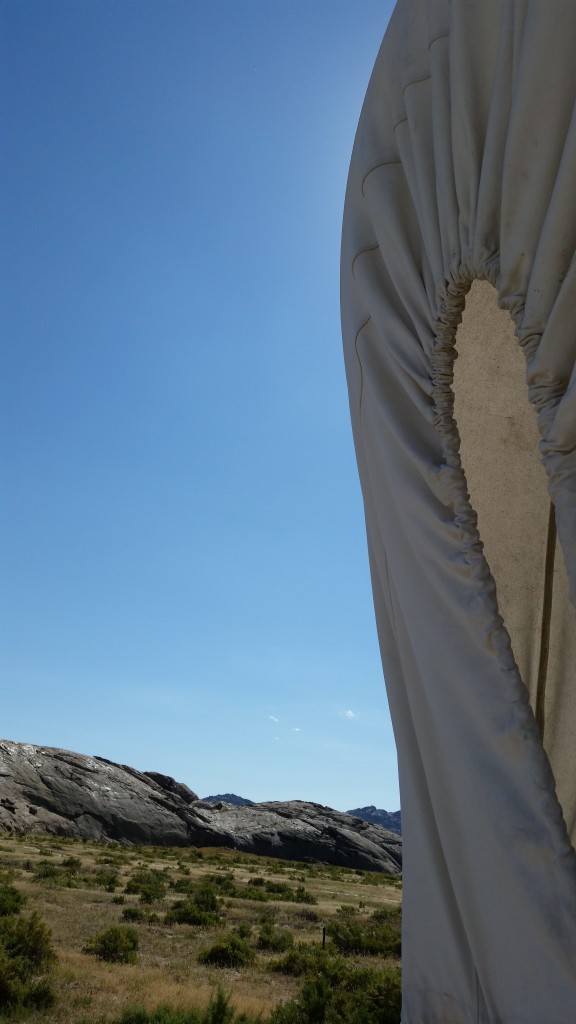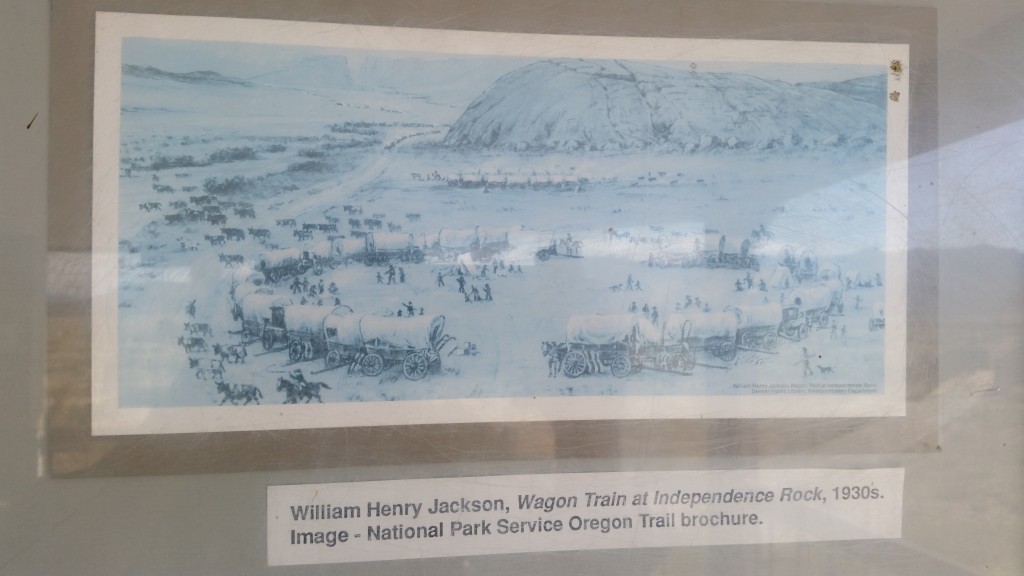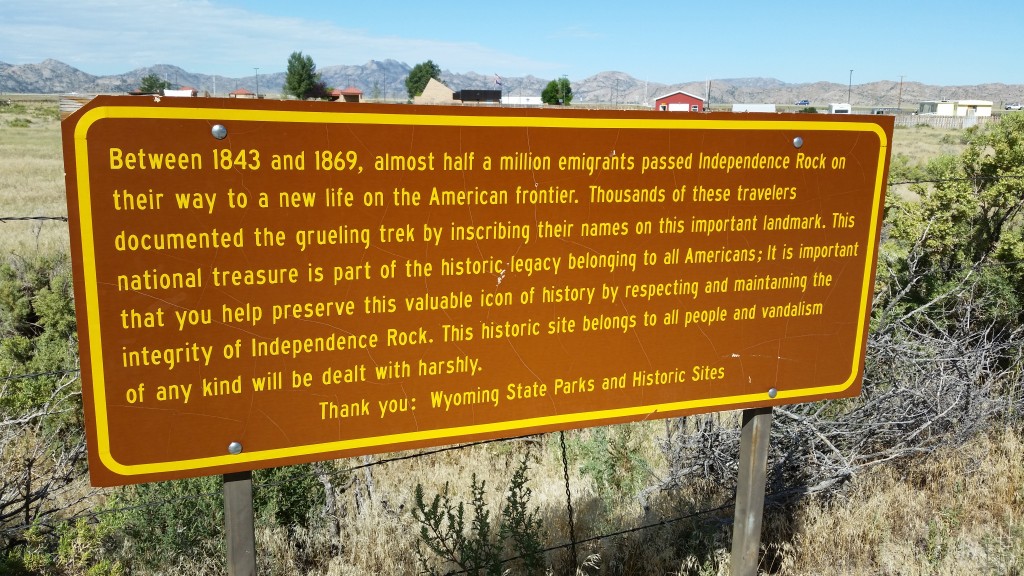If a person travels along the general route of what was once the Oregon-California Trail (I recommend taking the paved highways and not the deep-rutted trails left by thousands upon thousands of wagon wheels carting over 500, 000 pioneers in search of a future in the untamed West), right about the time he senses the need to get out and stretch his legs (about midway between Casper and Rawlins on what is the great, unending expanse that is Wyoming) he’ll see a massive rock formation described by one pioneer as an “enormous whale.”
According to those who understand how these things happen (without the benefit of having been there to observe it over countless millennia), this highly-polished outcropping of feldspar and mica was formed by a process of exfoliation. The stone was first exposed by erosion. Then, free from the intense pressure of the surrounding earth, it expanded—puffed out its chest, so to speak—and “shed its surface layers like an onion, “ dispensing with its granite exterior to reveal a round, whale-like shape. Once exposed, with nothing to break the elements, its surface was subjected to “wind faceting, ” blasted mercilessly by silt and sand year after year to the cumulative effect of being polished to a fine sheen.
These pioneers braved innumerable dangers, among the worst of which was disease on this desolate trail days or weeks away from medical care and any semblance of civilization. Travelers who died on the journey were often buried on the trail, where departing wagons and livestock would rumble over and pack the fresh grave in a needful sacrilege, securing the tomb and erasing the scent. But they also braved hazards unique to travel by covered wagon: drowning (wagons often tipped while crossing rivers), loss of supplies (wagons were also prone to tip while traversing steep and sharp-curved mountain passes), being trampled by livestock or run over by wagon wheels (tipping wagons tend to eject their passengers). Despite the dangers (it is estimated that 20, 000 died en route, “an average of ten graves per mile”) they went, by the hundreds of thousands, in search of the independence their destination (if not the journey itself) promised.
It was common practice for various wagon trains to set out at the same time, planning their trips to maximize spring grasses on their arrival, but avoid winter’s worst offerings in the mountains. If a group was on pace, they’d arrive at Independence Rock on the Fourth of July.
I tend to think of the pioneers as a somber lot, facing the gravity of their circumstance with appropriate sensibility and melancholy, but as the story goes, the weary travelers would celebrate at the rock with “sounds of gunfire, boisterous drinking and patriotic oration.”
[Tweet “Pioneers made their marks—a rock-solid insistence on their very existence—on Independence Rock.”]
And in days long before graffiti, even longer before the endless memorializing of ourselves and our moments on Facebook and Twitter, these sojourners made their marks, carving their names—a rock-solid insistence on their very existence and in their way, triumph—on Independence Rock, such that in 1840 Father Peter J. DeSmet named the place “The Register of the Desert.”
As a contemporary traveler, a person could find himself on a journey toward independence similar to that of the early settlers to the West, stripped of possessions and family and some days all hope, or like Independence Rock itself, stripped of its seeming protective granite layers and expanding into its new shape. Vandals in Wyoming may be treated harshly, so it is advisable to refrain from marking your name alongside that of a pioneer from 1848. But wherever you find yourself in your particular journey, you might find a place to puff out your chest and etch an insistence of yourself.
Photos and post by LW Lindquist.
Sources:
Wyoming State Parks
Oregon Trail Center
Browse more Literary Tours
- Earth Song Poem Featured on The Slowdown!—Birds in Home Depot - February 7, 2023
- The Rapping in the Attic—Happy Holidays Fun Video! - December 21, 2022
- Video: Earth Song: A Nature Poems Experience—Enchanting! - December 6, 2022




L. L. Barkat says
This is so, so fun. Yes, please 🙂
Will Willingham says
It was so cool, and I really stumbled on it by accident because I was afraid there wouldn’t be another rest stop for a while. I am hoping to climb it on my way home, and look for some of the etched names.
Charity Singleton Craig says
Love this, LW. When we traveled to Montana last summer, I just couldn’t get over how different the terrain and vegetation and climate were. Living in such a different place would just have to make a different person out of you. Thanks for sharing your journey.
Will Willingham says
It’s really striking, once you get to the western part of the Dakotas. Such a beautiful landscape, even in its seeming barrenness.
Maureen Doallas says
Love accompanying you, if only virtually, on these tours.
Will Willingham says
Happy to have you along. 🙂
Megan Willome says
Love it! My dad arrived in Cheyenne last night and will spend the next two weeks traveling back and forth across the state, fly-fishing. Thankfully, he and my Wyoming family members will not be traveling by wagon.
Will Willingham says
Oh, cool. I hope he has a great time. 🙂
Linda says
They were an adventurous, courageous lot. We spent time in that area a few years ago, and I was astounded at the beauty of the land and the bravery of those pioneers.
Thanks for this.
Will Willingham says
Can’t imagine what those travelers went through. Just can’t. 🙂
SimplyDarlene says
We are not all that far removed from this era. I mean, really, just a couple hundred years ago.
Three books that I’ve enjoyed on this topic are:
“Land of the Burnt Thigh” by Edith Eudora Kohl. “A lively story of women homesteaders on the South Dakota Frontier”
“We’ll All Go Home in the Spring” by Robert A. Bennett. “Personal accounts and adventures as told by the pioneers of the West”
“Wondrous Times on the Frontier” by Dee Brown. “America during the 1800’s – brought to life by a master frontier storyteller”
My family’s been blessed to live so close to many historical landmarks of the westward expansion timeframe, though none in Wyoming. Thanks for this telling.
Will Willingham says
Really something when you think about it, right? How many generations is it away? And how the world has changed. The sort of things we simply can’t imagine doing. (I can’t, anyway.)
Diana Trautwein says
Stunning pictures, LW, and great to remember the bravery (foolhardiness?) of all those who came before us to the great American west. We missed that stop in Wyoming. . . maybe we should go again some day? Hope your CA travels are somehow refreshing, even though work is at the center.